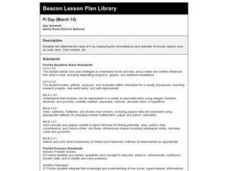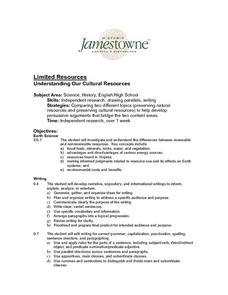Curated OER
Indirect Object- Direct Object Recognition Practice
In this nouns in sentences worksheet, students first read about the difference between direct and indirect objects. Students read ten sentences and write down the indirect and the direct object.
Curated OER
Indirect Object Pronouns
Directly address the use of the indirect object pronouns with a lesson on how to locate them in sentences and worksheets that provide opportunities for practice using them.
Curated OER
Combining Direct and Indirect Object Pronouns
Students combine direct and indirect pronouns in this lesson. They practice with rewriting sentences when a direct and indirect object is present. They create a story using PowerPoint with their new sentences.
Curated OER
Identifying Noun Clauses Worksheet
In this identifying noun clauses worksheet, students identify the type of noun clause in each sentence. Students decide if the clause is a direct object, indirect object, object of the preposition, predicate nominative, subject or...
Curated OER
Spanish Sentence Structure
Instruct your class on how to put together a sentence in Spanish. The resource covers the different parts of speech, showing how the Spanish version of each sentence compares with the English version. While there are no procedures...
University of Arizona
Fusing Firecrackers with Narrative
Improve your youngsters' descriptive writing. They study an object and write about what they see as a warm-up, then they read an excerpt from Paul Guest's memoir, One More Theory about Happiness. The next part of the...
Curated OER
Who / Whom Practice
In this nominative and objective pronouns worksheet, students read the rules for using "who" and "whom". Students read ten sentences and indicate which word is correct for each.
Curated OER
Using Gustar
Expressing that you like something in English is quite different from expressing that you like something in Spanish. Clarify gustar for your class with the information included here. Pupils can read the information on the webpage to find...
Curated OER
Reflexive Verbs
Understanding what reflexive verbs are in English will help your class understand them better in Spanish. Use this PowerPoint as an introduction to your "Verbos Reflexivos" lesson. It outlines reflexive verbs in English and Spanish,...
Curated OER
Pi Day (March 14)
Fourth graders determine the value of ? by measuring the circumference and diameter of circular objects such as soup cans, Oreo cookies, etc..
Curated OER
Subordinate (Dependent) Clause (Noun) Practice
In this noun clause worksheet, young scholars learn to recognize a subordinate or dependent noun clause. Students analyze the examples before identifying the noun clauses in ten sentences.
Curated OER
Who/Whom Usage Practice
In this who and whom practice worksheet, students read an informative lesson plan. Students then respond to 10 questions that require them to use who and whom appropriately.
Curated OER
An "Eggs"traordinary Sculpture
Eighth graders identify and categorize different types of animals which lay eggs, use a five step method for viewing and interpreting a piece of artwork, and use an indirect method to find the mass of a large object.
Curated OER
Recognizing All Subordinate Clause Uses
In this subordinate clauses practice worksheet, students read an informative lesson. Students then respond to 10 questions that require them to identify subordinate clauses and label them as adjective, adverb, or noun clauses.
Curated OER
User-friendly rivers
Pupils explore and explain their connection to rivers through watersheds. They break into three groups. Each group needs: Blue enamel paint, Miniature objects to simulate a model river system, modeling clay, Tempera paint, Toothpicks and...
Curated OER
Theatre: Meaningful Monologues
Students perform dramatic monologues. In this drama lesson, students write their own monologue and perform it in front of their peers.
Curated OER
Don Quixote
Students examine the use of metaphors in literature. For this literary devices lesson, students read poems that feature extended metaphors and compare them to the metaphors used in Don Quixote. Students then try their hand at writing...
Curated OER
The Cat in the Hat
Students participate in an emerging literacy lesson in order to focus on the skill of phonemic awareness. The letter "a" is the phoneme that is chosen for letter and sound recognition in the lesson.
Curated OER
Art or Artifact?
Students analyze and discuss illustrations of the New World by John White. They examine the images, answer questions about each one, and write an essay.
Curated OER
Imagery
Students listen to poetry and discuss the imagery. They write a creative poem demonstrating imagery. They write about imagery of a picture and visit a website to read poetry tips. They evaluate poetry using an evaluation form.
Curated OER
Nature and Haiku Poetry
Young scholars compose haiku poems and recognize how cultures value nature and
natural forces through the study of Japanese poetry. This lesson includes a bibliography of resources.
Curated OER
Baby Brown Bears
Students identify the letter and phoneme /b/ in written and spoken language. Students practice the production of the /b/ sound through riddles and tongue twisters. They identify the initial placement of the letter and sound using a...
Curated OER
Limited Resources - Understanding Our Cultural Resources
Students examine and compare preserving natural resources and preserving cultural resources. They conduct Internet research on two topics, and write a position paper on whether cultural resources or natural resources are more important...
Sophia Learning
Sophia: Finding the Subject and Object
This lesson plan focuses on finding the subject and objects of sentences; it does this using 4 videos. The first video explains what a subject is, how it is different from objects, and how to find the subject in the sentences; the second...























